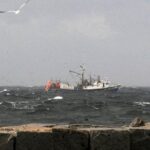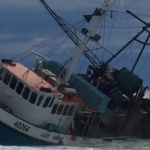The idea that “the public” will use Global Fishing Watch seems doubtful
 At John Kerry’s 2014 “Our Ocean” conference, a tuxedoed Leonardo DiCaprio introduced a new technology that promised to end illegal fishing across the globe. Global Fishing Watch boasted real-time monitoring of the world’s ships. This machine-learning spy tool was the result of a collaboration between the conservation advocacy organization Oceana, the satellite surveillance firm SkyTruth, and Google. After it collects and maps vessel location data transmitted from onboard satellite tracking devices, the program organizes all data points on a user-friendly Internet platform. For the first time in history, all fishing activity is recorded–even on the high seas that lie outside national jurisdictions. With Global Fishing Watch’s all-seeing gaze, states can adjudicate crimes to which they were previously blind. But the idea that “the public” will use Global Fishing Watch seems doubtful. The web platform lacks common features without which vigilantes would need a lot of training: pop-ups of helpful tips on what to watch for, alerts to specific hot-spots, built-in reporting mechanisms, or forums for users to share their experiences. Worse, those who the technology could most benefit–local fishers forced to compete with larger illegal ships–often do not have access to a decent Internet connection. If Global Fishing Watch is unlikely to be used by ordinary citizens of the countries most affected by illegal fishing, why is it marketed like a neighborhood watch tool? Read the story here 11:27
At John Kerry’s 2014 “Our Ocean” conference, a tuxedoed Leonardo DiCaprio introduced a new technology that promised to end illegal fishing across the globe. Global Fishing Watch boasted real-time monitoring of the world’s ships. This machine-learning spy tool was the result of a collaboration between the conservation advocacy organization Oceana, the satellite surveillance firm SkyTruth, and Google. After it collects and maps vessel location data transmitted from onboard satellite tracking devices, the program organizes all data points on a user-friendly Internet platform. For the first time in history, all fishing activity is recorded–even on the high seas that lie outside national jurisdictions. With Global Fishing Watch’s all-seeing gaze, states can adjudicate crimes to which they were previously blind. But the idea that “the public” will use Global Fishing Watch seems doubtful. The web platform lacks common features without which vigilantes would need a lot of training: pop-ups of helpful tips on what to watch for, alerts to specific hot-spots, built-in reporting mechanisms, or forums for users to share their experiences. Worse, those who the technology could most benefit–local fishers forced to compete with larger illegal ships–often do not have access to a decent Internet connection. If Global Fishing Watch is unlikely to be used by ordinary citizens of the countries most affected by illegal fishing, why is it marketed like a neighborhood watch tool? Read the story here 11:27

















































Leave a Reply